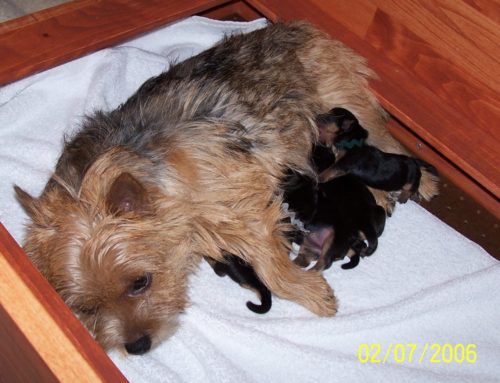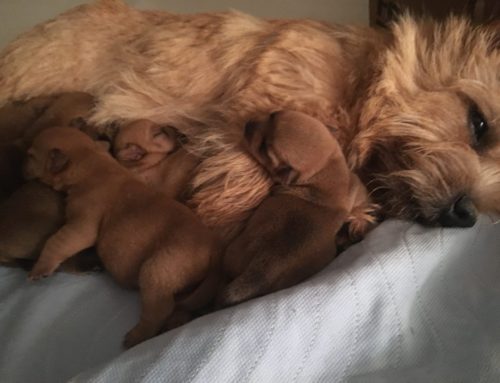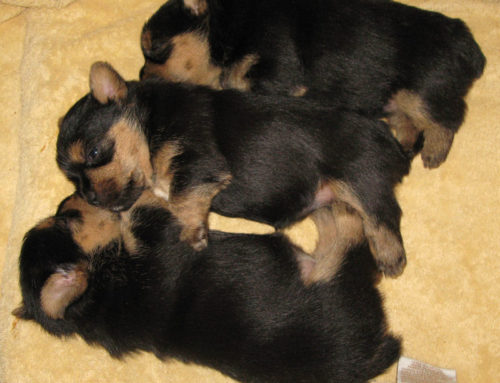The Norwich Terrier is one of the smallest working terriers. A hardy hunt terrier, he should have good bone and substance and an almost weatherproof coat. Our current official breed standard, approved in 1981, devotes a fair amount of space to describing the coat, including coat texture: “Hard, wiry and straight, lying close to the body with a definite undercoat.” Although the value of a weatherproof coat in a working terrier is obvious, coat was not my priority early on. As a new breeder, I had lots of other things to improve, and besides my Norwich were not going hunting—we were heading to the show ring! It was easy to make compromises given the plethora of products made to fool the judge (and conveniently sold at the dog show!). My old favorite was Plush Puppy’s “Ruffy Tuffy,” a coat spray especially for breeds that are suppose to have a hard textured coat.
Correct terrier coat in the show ring has been a topic for a long time. In 1952, R.C. Bayldon wrote about the Norwich Terrier in his article, “A Truly Sporting and Attractive Little Dog That Really Looks Like a Worker,” noting that the Norwich has, “so far escaped the extremist’s art — and, with a minimum of tidying-up, still appear AU NATUREL in the show ring,” but he warned about so-called improvements, observing that the breeders of others kinds of terriers in the past had made gradual “improvements” in the form of exaggerations and profuse, soft coats well-adapted to the ubiquitous barbering” (Norwich Terrier 1974 Pedigree Book and Club Trophy Records, compiled by Joan Redmond Read). Even earlier, Henry D. Bixby wrote about the importance of correct coats (Excerpts from AKC Column 1938-1940, Norwich and Norfolk Pedigrees Plus, 1978). “The real Norwich terrier coat, hard and wiry, but lying close to the body, as it does, sheds dirt easily. I believe that the proper coat is one of the first things for our consideration, as is also size.” He observed that soft coats seemed to be in the majority at shows, contrary to standard requirements. “This fault is very bad, for the individuality of our breed depends on his flat, harsh coat.”
The renowned Norwich and Norfolk breeder, Joan Read stressed the importance of correct coats, noting that “in the beginning non-trim coats were in the majority.” She asked, “Are breeders really trying to produce small game hard-coated terriers with the stamina to follow a horse all day? … It’s time to remember our breed’s working terrier heritage which eschews the barber’s art for being correctly clad by nature.” She attributed the rapid physical changes from working terrier to show dog that had taken place to line and in-breeding, and warned against measuring success by ring recognition—by then, both the Norwich and Norfolk, on both side of the Atlantic, had won Best in Show awards and many Groups. Since then, much has been written about dog shows and how they have influenced breeds over time. Nearly two decades have passed since Annie Rogers Clark wrote, “We can remember the old-fashioned reason for having dog shows, breeding better healthier sounder dogs.”
With Ruffy Tuffy in hand and a bit of show ring success, I didn’t pay much attention to the correct Norwich Terrier coat until quite by happenstance, I acquired a bitch whose hard wiry coat was so easy to groom and keep in shape that the practical value of a correct coat was apparent. While health and temperament take priority, I now appreciate a correct natural coat as one of the important breed characteristics. As breeders, we all start somewhere working with what we have, but we need a sound idea of our own priorities and compromises need to be deliberate. Although most terriers no longer participate in the actual work they were bred to do, if we are to preserve their history it is important to retain essential breed characteristics.
Jane R. Schubart, AKC Gazette Breed Columnist ascot.js@gmail.com; The Norwich Terrier Club of America website: www.norwichterrierclub.org (717) 635-8464





